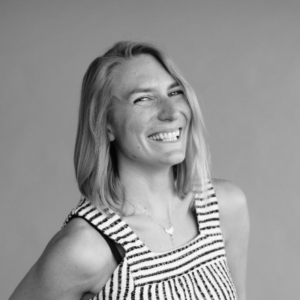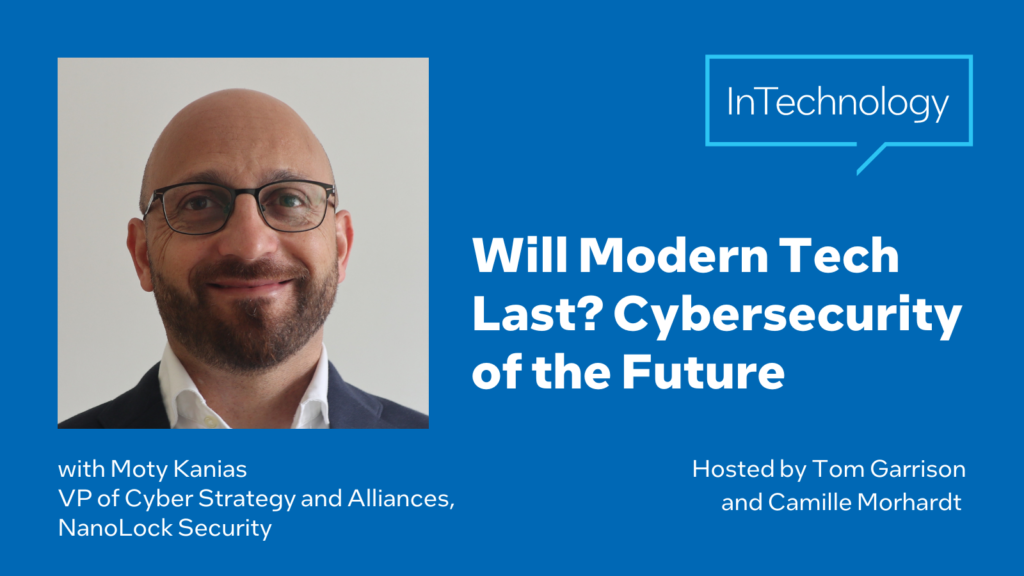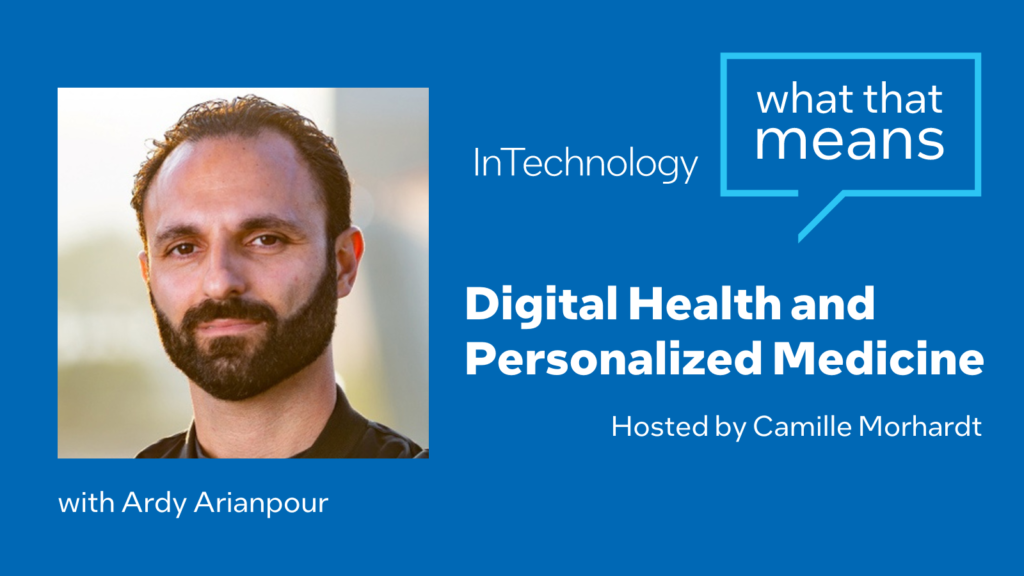[00:00:35] Camille Morhardt: Hi, and welcome to today’s podcast In Technology, What That Means. We’re gonna focus on zero waste today with Marina McCoy. She does education in zero waste, and she also has a couple of companies tell us what the companies are, Marina.
[00:00:50] Marina McCoy: So my first one is Waste for Earth. It’s been in business for 10 years now, and we do zero waste education for events is how I started off. So we would set up reusable systems at events and educate vendors, attendees, artists, and then when COVID happened, we switched to businesses. And then I also opened up a zero waste refill shop in downtown Burlington where I’m based. And there you could go in and refill on laundry detergent, hand soap, conditioner, shampoo, essentially anything that’s home goods related that comes in a single use bottle you could refill at the shop.
[00:01:26] Camille Morhardt: So one of the things that you focus on is waste reduction at an individual scale. How did you choose to do that as opposed to look at company or industry-wide scale?
[00:01:38] Marina McCoy: I look at it through a lens of the ripple effect. Cuz when you start to make changes in your everyday life to reduce your waste, if you’re in the manufacturing business or if you’re in an office that’s producing a lot of waste, once you start to build that foundation of zero waste education, you’ll start to see other ways to reduce waste.
So people like when we do workshops, they’ll email me afterwards and say, “oh, I got my office to now reduce the amount of printing that they’re doing.” “Oh, I found out that this isn’t recyclable. So we’re no longer ordering that, or we just completely eliminate it.” So that’s where I see the big difference. So on an individual level, yes, it could get discouraging when you find out that all these companies are producing way more waste than you could ever imagine.
But if you start with the individual, they actually have a big impact in the grand scheme of things. It’s just that sometimes people don’t realize it.
[00:02:32] Camille Morhardt: Hmm, okay. So you, you look at people to be able to extend what they’ve learned beyond their home environment.
[00:02:39] Marina McCoy: Exactly. About 10 years ago is when people really started to look at the waste that they were producing on an individual level and then starting to look at businesses and now more people are talking about it, which is great cuz for me, I really believe zero waste is at the center of most of the climate issues that we have.
I was studying food systems and then that woke me up to food waste and how much waste certain companies and grocery stores create. It’s kind of a rabbit hole of things. You see how much food waste we’re creating and then that opens a bigger picture. Okay, what else is being wasted? And then you look at the fashion industry and then also plastics are a big thing. And the single-use convenience lifestyle that we have for food.
[00:03:23] Camille Morhardt: Do you feel like digitally now we’re better able to track some of the waste or potential waste?
[00:03:30] Marina McCoy: Yeah, there’s the life cycle assessment programming that a lot of businesses tend to use. So if you’re producing a product, it’s not just about the waste at the end of the life. It’s about how much energy and resources went into it, how much water went into it, how much energy went into it. What about the raw materials? So a lot of companies use that assessment to better gauge how much waste they’re producing and the whole life cycle of it.
And that’s why I bring up how waste is kind of at the center of climate issues because we’re talking about carbon dioxide and the atmosphere and how we should reduce it. And a lot of that comes from factories. But what are those factories producing? They’re producing a lot of single- use items. They’re producing items with the planned obsolescence so that they’re gonna break after a few uses or after a couple years.
So for me, that’s where we really focused on is how can we make products that last longer so that their life cycle assessment is greater instead of being of lesser quality, that adds more waste into the environment. And then that means more resources being used.
[00:04:38] Camille Morhardt: Do you see this as driven by, you know, at the consumer level or the end user level, or do you see it as being driven by innovation within industry?
[00:04:49] Marina McCoy: Well, it started as a consumer movement through social media and other outlets. They became more aware of the waste that we were producing, but companies, I would say took a little bit longer to catch on because there are money saving incentives with it. But then there are some more economic financial investments that people need to make in order to be more waste free.
I’ve seen a greater increase of companies now listening to consumers asking for more sustainable packaging, which has been really awesome to see. But then along those lines, it opens up to more green washing where companies add on the recycling symbol cause there’s no regulations on if products could have the recycling symbol on ’em, even if they’re not recyclable. So more companies are doing that, too.
So even though other companies are taking greater strides to be more sustainable in zero ways, you have other companies that are greenwashing their efforts, making it seem like they’re doing more than they actually are.
[00:05:50] Camille Morhardt: How do you, like, as a consumer, how would you or, or as business who’s making contract decisions, how do you know if you’re being greenwashed, what are some kind of telltale signs on that?
[00:06:02] Marina McCoy: It really depends on the business and what they’re producing. So for packaging, if it’s a lot in the colors that they’re using, if they’re using green, and also the um, words that they’re using, like “eco-friendly” “green,” like what is green actually? Mean, what does eco-friendly mean? What does “non-toxic” or “chemical free”? Technically water is a chemical, so it’s, it’s really hard to figure out at first if a product is actually sustainable or not.
Cuz also like what does sustainable mean anymore? Because there’s like financial sustainability and environmental sustainability and social sustainability. But to bring it back to the greenwashing efforts, you really have to do your research on like even just a simple Google search, you could find out if something is recyclable.
[00:06:54] Camille Morhardt: So if they’re not global standards for zero waste or sustainability, then is each company or possibly even industry or region defining, like you said, sustainability is kind of a, well, I, I suppose, reasonably well agreed upon at this point to have three legs, right, those sort of, uh, social, economic, and environmental. Is each company or industry or region. Setting a goal within each of those legs and then stating how close they are to that, and that’s our best definition. Or is there any kind of holistic definition for it?
[00:07:33] Marina McCoy: More and more states are putting in place zero waste plans, like we have one here in Vermont, too. I’m actually on the Waste Stakeholder Group. And for us, we’re trying to reduce our overall waste consumption by 15%, and that’s a pretty ambitious goal. But our landfill, I’m blanking on how many years that we have left on our landfill, but it’s coming up in about two to three decades. So for us, we’re really trying to reduce the amount of waste and figuring out what industries are producing the most. And I know other states around the country are doing that as well, but then you have states that don’t see the pressure for it just yet.
As a whole around the world, I don’t see any big global standards for it, but I think it’s great for everyone to push forward through with it.
[00:08:22] Camille Morhardt: What are some of the low hanging fruit and I, you know, feel free to comment to if it’s different depending on where you are. I know some, some things that are kind of popular right now are separating out compost so you don’t have food waste going into landfill. Help us understand what other kinds of things.
[00:08:39] Marina McCoy: For us, we have this zero waste roadmap or waste free living timeline that we call, uh, Waste Free Earth, where it has five different steps that you could take. The first step is inventorying your waste, so going through a section of your house. I usually tell people to start in the kitchen or the bathroom. Go through, and it depends on how in detail you wanna go, but I organize it all by materials–plastic, aluminum, cardboard, paper. So write down everything and then you’ll be able to see your biggest key waste contributors.
From there, you could move on to Step 2, where you’ll eliminate three things immediately. So say you’re chewing a lot of gum, or you have magazine and junk mail subscriptions that are coming in, you could eliminate those pretty easily. And then Step 3 is reducing what you’re having. So maybe you are really big on eating yogurt and you’re buying five of the little containers each week. Instead go for the bigger containers. So that’s a way to reduce the waste that you are producing. So you don’t always have to eliminate something right off the bat. And sometimes you won’t be able to eliminate something completely, cuz it can be unrealistic. And many different counties, it’s just not as accessible to people.
And then we say Step 4 is to swap out, like if you’re using single use water bottles, go for a reusable ones. Same with single use napkins. Um, tissues. Go for a hanky instead. I love my hanky. I use it for everything . Um, but we wanna get people to do Steps 1- 3 first because you don’t wanna ha, feel like you’re have to buy step to be zero waste.
And then lastly on Step 5 is collect your waste. If you start collecting your waste right off the bat, you’re gonna get overwhelmed. Cuz people always think that they’re producing less waste than they actually. So once you do Steps 1 – 4, then we say to collect your waste for at least a week a month is a really good number to kind of go for. But sometimes again, it’s unrealistic if you have a family of four, if you have a kid, it’s a lot different than being a single person collecting their waste. So we always try to let people know, do what you can, where you can, and allow room for error because we’re all human.
[00:11:01] Camille Morhardt: Well, it seems like we’ve been talking about kind of product waste. What about electricity or gasoline, water, battery power, this kind of thing. Is there a way to measure these from a zero waste perspective?
[00:11:17] Marina McCoy: Yeah, there’s tracking available through a lot of the companies. So for living in Vermont, Burlington Electric, I could see how much electricity I’m using. Every day, every week, every month, which is really helpful. And same with gas. So being able to look at your bill and see how much waste that you’re producing for electricity and oil, and even water. Water, sometimes if you don’t live in a drought prone area, people forget that water is a valuable resource. So paying attention to your bills and not just saying, “oh, I have it on automatic bank withdrawal.” Like you’re not really looking at the bank statement and how much was that you’re producing in terms of that. Like I was guilty. Of that, and now I’m trying to track it more, especially living in a small apartment, sometimes you forget to maybe like turn off the lights or to reduce your water intake. So just trying to track that, your invoices can be really helpful in that manner.
[00:12:19] Camille Morhardt: What would it look like if you had just a really big win like 10 years from now? Kind of, you know, how many people could change and how much could they change and what sort of a difference would we see.
[00:12:30] Marina McCoy: Again, like speaking to the ripple effect, if more people started to reduce their waste–if they’re able to (again, like I’m speaking from a privileged aspect.) But if more people started to reduce the race and push towards companies to have better packaging available to them. So if maybe you’re not able to reduce our waste, still writing to the companies and asking them to package more sustainably. If we all start to reduce our waste, little by little, doing what we can, where we can, I am hopeful that our carbon input into the atmosphere will drastically reduce.
Because if you’re looking for how much energy it takes to recycle a can, aluminum can, versus making a new one, you’re saving 95% of the energy it takes to produce a new can when you recycle a can. So aluminum is highly recyclable. If you are not able to, uh, completely eliminate something from your key waste contributors, looking at recycling and composting is a great effort too.
[00:13:37] Camille Morhardt: Is there something big scale that needs to happen in order for people to truly make this kind of a transition if they’re interested in doing it?
[00:13:46] Marina McCoy: Yeah, I would love to see more regulations on what companies can put on their packing. A lot of the responsibility ends up on the consumer, which I don’t think is right because we’re not the ones producing the waste. Sometimes you just don’t have the choice. Cause the plastic industry lobbied to have the recycling symbol on their plastic without it actually being recyclable. So people see that sign and they see plastics like one through seven on there. But that doesn’t mean that it’s actually recyclable. It’s just a plastic identifier. For what type of plastic it is. So that creates a lot of confusion.
And also people could put the word “recyclable” on it or “made with recycled content,” which doesn’t mean that it’s recyclable at the end of its life. So it’s really confusing for the consumer to actually know what is recyclable and what’s not. And same with “compostable” and the word “biodegradable.” People think that biodegradable equals compostable, but everything is biodegradable within due time. It’s just a matter of how long it’s, is it. A couple months or is it 500 years
Right. So it’s, it’s tricky. So that’s why we really try to educate people when we do trainings and workshops so that you feel empowered to make better decisions when you are going to the store. And again, talking to different companies and seeing if they can reduce the amount of plastic. That they’re using.
[00:15:08] Camille Morhardt: It seems to me ideally, it’s not a matter of compromising what you’re using or what you’re wanting, and rather replacing it with experiences or items that are not a drain on the environment. If you’re using solar, and again, I understand there’s battery implications there, but if you’re using solar, then it might not matter if you’re reducing your net use.
If it’s like real time coming into your house, who cares how much you use if it’s coming in from your roof, or I suppose there could be a closed loop system with water where it doesn’t matter because you’re putting it all back. It’s all coming back out clean again, versus kind of more of a limitation approach to things.
I’m just wondering what gets people comfortable making a change?
[00:15:59] Marina McCoy: I would say when they know more of the information and they feel empowered. Mm-hmm to do something for me. Once I started to find out more about food waste, I got a little bit discouraged, but I felt empowered to do something because I realized that I had the ability to really take a hold of this and reduce waste where I could.
Whereas maybe that’s not the case for some people, again, depending on where you live, but for me, I was able to make that shift and empower others to do that, as well–through education and through watching documentaries and reading books, and listening to podcasts, and also touring, recycling facilities.
Really fascinating going there. And when we were producing sustainability departments for events, we would sort through all the trash. So we learned so much about human behavior. And what people were consuming and also where they were getting stuck on like, Again, those packs of like soup and water that looks like they’re coming in a cardboard container. A lot of people, again, thought that they were recyclable, so we had to switch our signage and our education to let people know that it wasn’t, because it’s not as easy saying, paper is recyclable, cardboard, glass, and aluminum. Cuz if something’s made of all those, then people think that it makes it recyclable. But really you just want one material. Like glass aluminum cause again, the MERF and the recycling facility can’t tear that apart it has to be special recycling.
For one event, over the course of a couple of years, we were able to go from three 30-yard landfill dumpsters to just one landfill dumpster. So we had a massive decrease in that. And another one, we were able to reduce the overall waste consumption by 120,000 pounds. And that’s just again, through going in, working with vendors, educating attendees, educating artists on what is recyclable, compostable, and items that are banned from the event, which leads to the reduction of waste. So it’s really fascinating. I love doing that work.
[00:18:12] Camille Morhardt: What’s the first thing you flip to if you’re looking up, uh, like a corporation to see if they’re. Zero waste or moving toward it or, or sustainable what? What do you look for?
[00:18:24] Marina McCoy: Well, first we do a waste audit. We ask them if they’ve ever done a waste audit before, and if they haven’t, we lay down a tarp, put on some jumpsuits, and go through their trash recycling and compost if they’re doing it. Cause from there we could really see the basic knowledge that they have on the different types of waste streams. Then we could start initiating the programming with trainings, workshops, educational signage.
So that’s kind of how we figure out if a company is inherently zero waste on the foundational side, like educating their staff members. And then from a first glance, too, when we have the interview, we sit down with them and the consult, we’ll ask them what initiatives they have in place.
[00:19:08] Camille Morhardt: Yeah, I mean, you’re, you’re looking at what the cost is or the environmental cost is to operate the business. But what about, um, the products that they’re producing or what about the services or products that are going into their products? Do you look at the supply chain coming in and the energy being used in production and things like that?
[00:19:29] Marina McCoy: Yeah, that’s more of the life cycle assessment. We aren’t experts in it as much as we are with the foundational education side of things. But again, if we educate the manufacturing team on what is generally recyclable, Compostable and what is landfill and there’s no specialty recycling programs for then when they’re building their stuff and the engineers, they’re now gonna have more information so that they could go for certain materials instead of other ones. And that also, like if they have someone on the team that is doing the lifecycle assessment, it all works together.
[00:20:05] Camille Morhardt: Is there anything being argued about right now in the zero waste space?
[00:20:09] Marina McCoy: I would say it’s mainly greenwashing and the compostable products because most compost facilities are no longer taking compostable products. You have the compostable plastics. Those are no longer getting accepted at compost facilities. So for us, it’s really important to educate the community, the staff members that. The compostable products are actually no longer compostable.
[00:20:35] Camille Morhardt: Do they just have too many of them?
[00:20:37] Marina McCoy: So it’s kind of complicated, I guess, in ways, but also simplistic. So to have a compostable product or altering corn per se, to make it compostable, that requires a lot of energy to be used in resources to like grow the crop and then convert it into a form of plastic. And they tend to have a higher melting rate of like 180, 200 degrees and you don’t want your compost pile to be that hot cause it was gonna kill the nutrients that you want to help grow the food.
When we found out things couldn’t be recycled if they had food waste on them. We went to compostable products. Instead of looking at like reducing our waste or using reusables, we just immediately jumped to the next best single use plastic or compostable plastic item instead of really trying to reduce and re-reuse our stuff. So now since the compostable stuff is no longer compostable, we’re going back to trying to reduce and use re-usables instead.
[00:21:41] Camille Morhardt: Thank you, Marina. I, I appreciate the conversation and I appreciate your time.
[00:21:46] Marina McCoy: Yeah, thank you so much for the opportunity.




